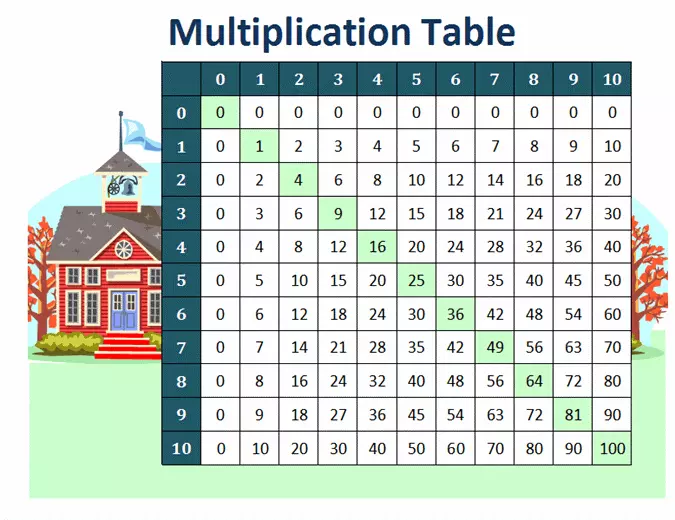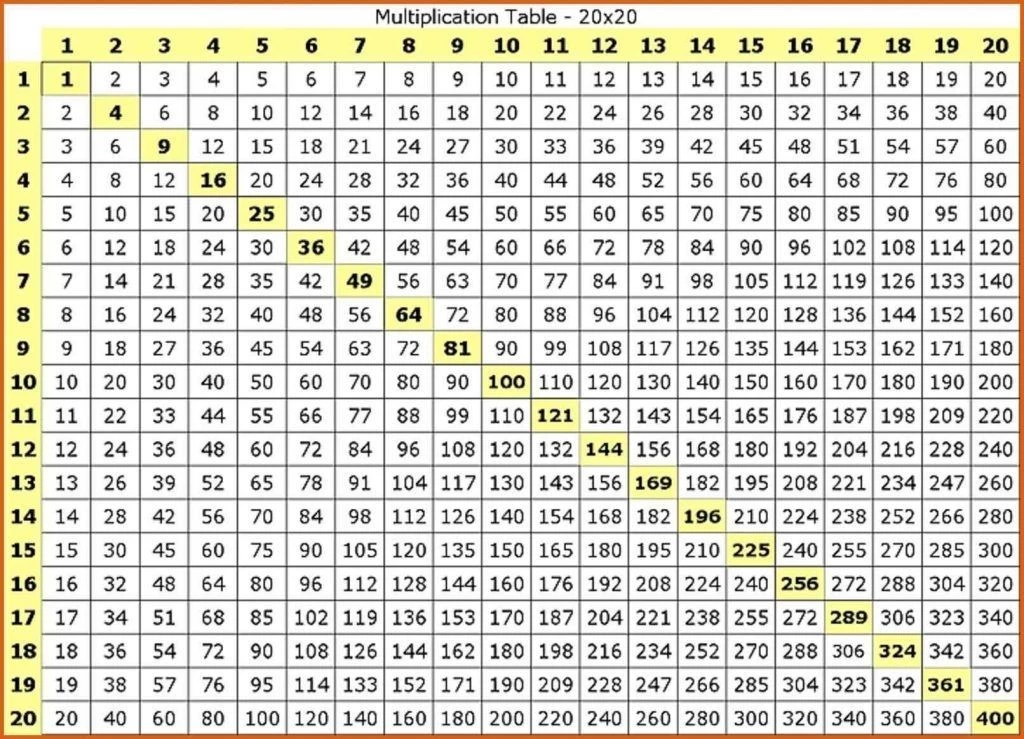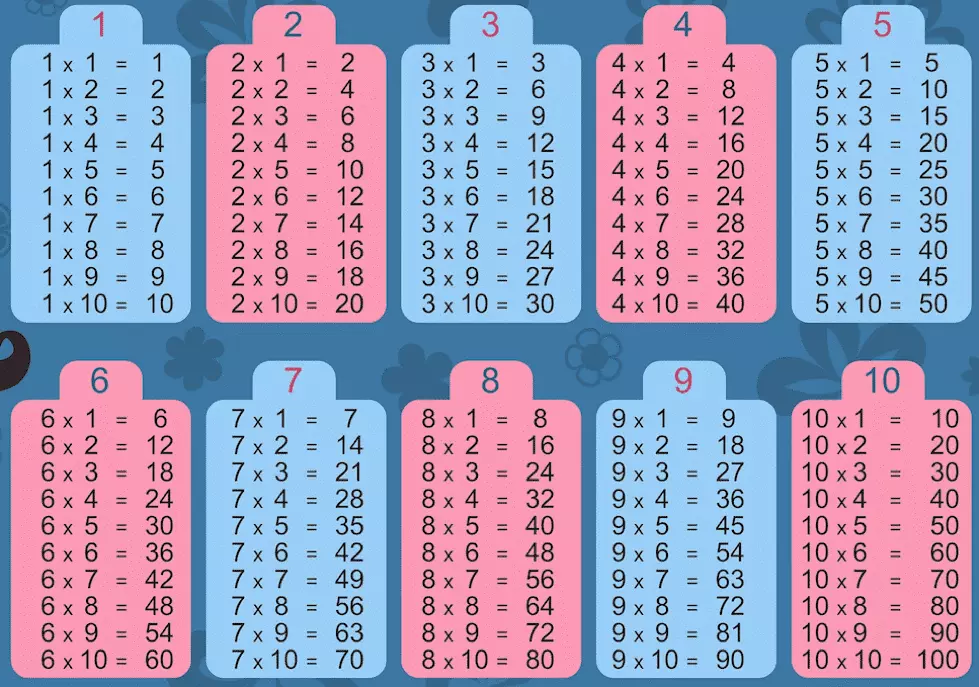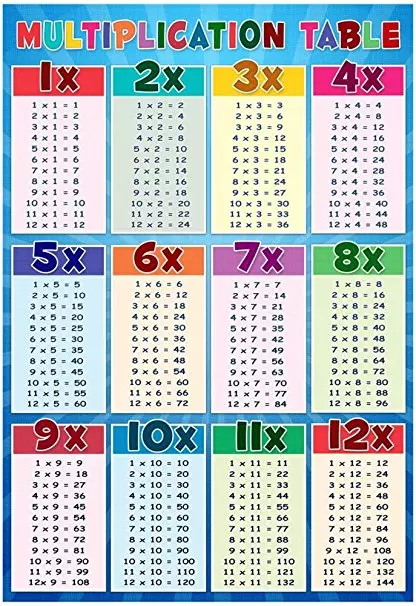A list of the number multiples is known as a multiplication table. The multiplication table may be obtained by appropriately multiplying the supplied number by whole numbers. The mathematical operation of multiplication is one of the fundamental operations introduced to pupils at a young age. A multiplication table chart is a valuable tool for providing pupils a straightforward introduction to multiplication.
Knowing your timetables may be a precious tool when completing calculations in elementary mathematics. These are the foundation for more advanced mathematical operations such as fractions, exponents, and many more. You are given printable versions of multiplication charts and tables to make it easier to master the timetables.
Multiplication Chart
A multiplication chart is a table that displays the result of multiplying two integers. In most cases, one set of numerical values is recorded in the left column. In contrast, another group of numerical values is recorded in the top row. Using a multiplication chart can save significant time and effort in mathematical computations.
Multiplication Chart from 1 to 10

The numbers from one to ten are written in order across the top row and the left column of the grid that makes up the time’s table chart for one to ten. Each box in the remaining rows and columns represents a number as the product of two numbers; one number comes from the row to the far left, and the other comes from the row to the far right.
Multiplication Chart from 1 to 20

Learning multiplication tables is essential for calculating several digits and finding solutions to issues involving fractions, percentages, and factoring. A youngster who has mastered these multiplication tables from 1 to 20 is better able to do mental arithmetic and handle more complicated computations.
A table of multiplication is a list of the numbers that are multiples of a single integer. It is a device that is used in the process of learning how to multiply two integers together. We can compute answers more quickly and simply with a times table.
Significance of Multiplication Tables
Calculations in mathematics begin with multiplication tables, often called times tables. These tables are the fundamental building blocks. The memory of a youngster is far more robust than the memory of an adult. The things we are taught at a young age have a profound effect on the brain, and we can remember them throughout our whole lives.
- Students benefit from having access to multiplication tables as they pursue their mathematical education.
- They will have a solid understanding of the facts connected with multiplication as a result.
- It helps pupils more easily figure out the solutions to their mathematical problems.
- Students with a solid foundation in multiplication tables often have a more positive attitude about their mathematical education.
How To Practice Multiplication Tables
You’ll find some helpful supplementary material on the practice of multiplication tables in elementary school here. The first time’s tables to be learned are the one-time table, followed by the two-times table, the three-times table, the four-times table, the five-times table, and finally, the 10-times table. The following phase involves learning the six times table, the seven times table, the eight times table, the nine times table, the eleven times table, and the twelve times table, as well as all of the tables in a random sequence.
Because not all children find it simple to learn all the tables, it is a good idea to continue practicing them regularly after you have already mastered them. There are a few strategies that may make it simpler to learn multiplication tables and continue to master them.
One of these strategies is to put the lowest number first, which makes it easier for many youngsters to provide the proper answer. For instance, it is simpler to calculate 4 x 9 than to calculate 9 x 4. It is much simpler to solve the question if you turn the multiplication total around. Utilizing the tables, you are familiar with to solve the amounts in the more challenging tables is another often helpful strategy. One such problem is the 6 x 7 equation, which has a reputation for being difficult.
It becomes much simpler to solve the question if you first multiply five by seven and then add one by 7. You may even do this in the other direction as well. For the problem 4 x 7, for example, you may calculate 5 x 7 and then deduct 1 x 7.
The tables of multiplication will continue to be vital to you for the remainder of your time in primary school and even into your time in secondary school. You shouldn’t think of them as tables but as components of more comprehensive mathematical problems.
Not only is it helpful to know your timetables well at school, but it is also helpful to know them in your daily life so that you can rapidly calculate things. For example, knowing your timetables well is essential when buying or selling vegetables at the market. Please use our contact form if you have any inquiries, feedback, or suggestions about Timestables.com. It would be wonderful to have some input from you
The 5-Step Plans
The 5-step strategy is an effective way to learn your timetables. To assist students in realizing their multiplication tables in an effective and time-efficient manner, we devised an original five-step strategy. Educators have evaluated this strategy at several schools, and their feedback has been positive.
The following are the steps:
Step 1
Look at it, read it out loud, and do it again to get acquainted with the table. Fill in the answers to your multiplication tables in the correct order, and then check to see whether you got them all correctly.
Step 2
It is to drag the appropriate responses to the corresponding questions.
Step 3
Check to see whether you have correctly answered all of the mixed questions once you have filled in your responses to those questions.
Step 4
This step is to use multiple choice questions, which will assist you in improving by requiring you to examine the questions in a new manner.
Step 5
Demonstrate your mastery of the material, and get your certificate.
After you have completed the first five stages, you may either practice with the worksheet or play the memory game. The tempo exam, the one-minute test, and playing games based on multiplication tables are three other ways to get further training.
Online Table Practice?

Because there are not a lot of locations where you can learn multiplication tables quickly and easily, we decided to create Timestables.com. Multiplication tables are critical, and there are not a lot of places where you can understand them. At Timestables.com, you won’t have any trouble practicing your tables in an online setting. You won’t have any trouble following along with the straightforward and straightforward multiplication games.
Get started by selecting one of the tables and clicking on it. After you provide your answers, you will be prompted to click the ‘check’ button. You will immediately see which responses are accurate and which are erroneous. You may also test your knowledge of many times tables simultaneously by practicing them all together in a single activity.
You may also get interactive practice with the tables by playing the free multiplication games on our website. We have just added a table balloons game and an answer-dragging game to the area dedicated to multiplication games.
You must have a thorough understanding of multiplication tables since they serve as the foundation for the calculations that you will do in subsequent years.
Tips To Memorize Multiplication Tables

Students often have a difficult time learning their multiplication tables by heart. Students having trouble teaching these times tables might benefit from our helpful hints.
- Putting “skip-counting” into practice
- Recite the table of multiplications in the correct sequence.
- Exercise your writing skills.
- Put your multiplication skills to use in the real world.
- Identify patterns
Putting Skip Counting Into Practice
It would be finest if you began with a number and added more. For example, if you start with 3, continue adding three after each total iteration. So you can say 3, 6, 9, 12…
Narrate The Following In Order From The Multiplication Table
For example, you may say, “two times one is two, two times two is four,” and so forth. It would be best if you made it a habit to repeat this table once daily until you have a firm grasp on the format it adheres to.
Become Familiar With The Reverse Table Recitation
Master the art of reciting the multiplication table in reverse. Beginning at the bottom of the column is where you should start. For example, you may begin by saying, “2 times ten is 20,” or “2 times 19 is 38,”.
Exercise Your Writing Skills By
You always have the option of writing down the multiplication table and learning it that way if you find yourself having trouble remembering it by heart. Make it a habit to write down the multiplication tables and then go through the motions of reciting them once daily.
Putting Multiplication into Practice in Real Life
Make an effort to comprehend multiplication tables by utilizing examples from everyday life. If it is at all feasible, you might also attempt to exercise your multiplication skills within a variety of different situations. For instance, you were multiplying the price of one thing by the total number of goods in the bundle or multiplying the full amount by the total number of individual notes in a pile.
Identify Patterns
Every single table of multiplication has its unique design. The recognition of this pattern is of the utmost significance. It will make it easier for you to commit these multiplication tables to memory.
